#thanks for the correction by fouryearsofshades
Note
Secondly, I have heard that as traditional fashion gets more and more popular, there is an increasing amount of fake/knockoff clothes sold online, is there a way to distinguish between them, so we can buy hanfu from official brands and support the designers and dressmakers for their hard work.
Hi, thanks for the question, and sorry for taking ages to reply!

Yes, that's correct -- knockoffs (known as 山寨/shanzhai in Chinese) have long been, and still are, a huge problem for hanfu vendors. It's often difficult and confusing to tell the difference between original hanfu and shanzhai hanfu.
I highly encourage everyone to do some research before buying hanfu to make sure that your purchase goes towards supporting the original brand/designer, as opposed to a counterfeiter. Without that financial support, it's very likely for original brands and designers to close shop, especially in the extremely competitive hanfu market.
Based on personal observation, below are some red flags that may signify that a hanfu shop or item is a knockoff - or at least not from the original brand/designer. Note that these refer mainly to Taobao shops because Taobao is the platform I'm most familiar with:
Examine the merchandise. Shops that offer an assortment of non-hanfu related products (e.g. mainstream contemporary fashion, household items) in addition to hanfu, are usually not original hanfu brands. Authentic hanfu brands typically only sell hanfu and related items such as modified hanfu & hanyuansu, hanfu accessories, and occasionally other types of Chinese clothing (e.g. qipao/cheongsam, Qing dynasty-style clothing).
Examine the photos. If a shanzhai shop doesn't outright steal product photos from the original brand, it may retake photos of the clothes using different models. These models and photos are usually very generic and low-effort. Original hanfu brands typically put more creativity and effort into styling models and designing photoshoots for promotional photos.
Examine the prices. If a hanfu's price seems too good to be true, it usually is. It's likely to be a knockoff - or at least of lower quality than expected. This isn't always the case, as some original hanfu are hugely discounted, and some knockoffs inflate their prices. However, you get what you pay for, and I'd avoid super cheap hanfu if you want to ensure authenticity.
More tips from @bamboocounting: "you can check the storefront to see if the store has been running for a time that matches when it’s founded, for older famous stores, and check the number of reviews for some more popular items (like Shisanyu regularly has hundreds of reviews for some sets)."
In addition, @fouryearsofshades mentioned here that there's an official account on WeChat called 汉服安莉 that can be used to check if a shop is authentic. My dms are also open if you need assistance with checking whether something is authentic - I'll do what I can to help ^^
If anyone has additional advice, please share!
Hope this helps!
(Hanfu photo via)
#hanfu#store#taobao#hanfu recommendations#reference#ask#reply#chinese fashion#chinese clothing#china
273 notes
·
View notes
Photo


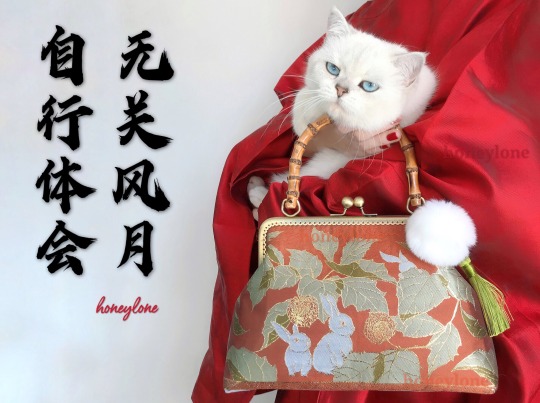
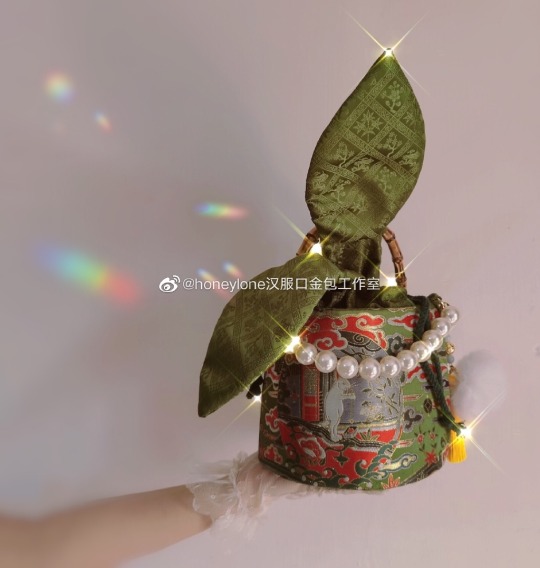
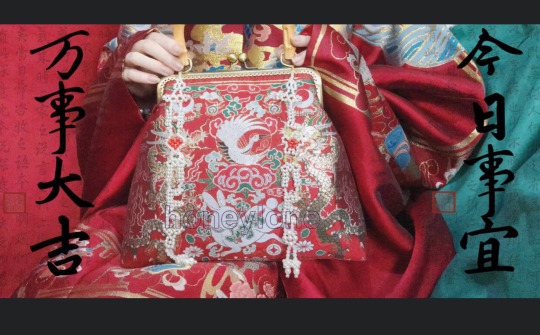


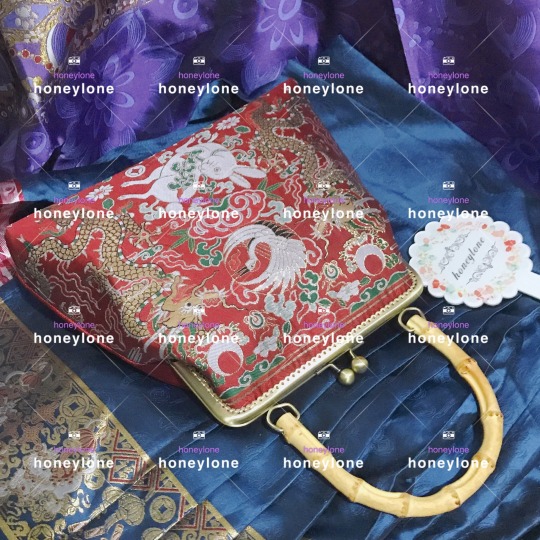

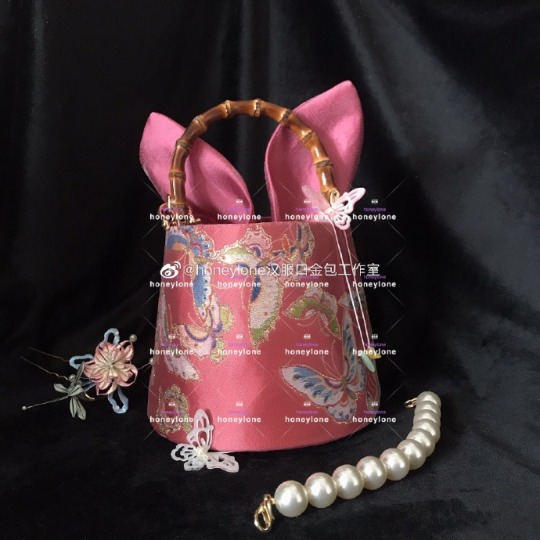


brocade handbag for chinese hanfu by honeylone
#china#fashion#chinese fashion#bags#accessories#these bags are usually made of hanfu fabric which coordinates well with hanfu.#thanks for the correction by fouryearsofshades#it's brocade#not embroidery
233 notes
·
View notes
Note
hey i was wondering do you know chinese symbolism for lesbians? just wondernig
Hi, thanks a lot for the question, just in time for pride! @fouryearsofshades got a similar ask recently as well, I have some long ass explanations so I’ll answer to this instead of reblog.
Mirrors
A common one I read about is the term 磨镜 mojing or “polishing mirrors”, which apparently refers to both lesbianism and specifically a lesbian sex act. Maybe scissoring given the imagery? It wasn’t very old and probably dates no earlier than the 19th century. Apparently there was a whole lesbian club/organization named after this term in belle epoque Shanghai (1890s-1910s) called the 磨镜党 or “polishing mirrors society”, according to the collection of accounts from the Qing Dynasty 清稗类钞 compiled by 徐珂 Xu Ke in the 1910s.
Hair updos
Another term for lesbians specific to the southern Canton coast region is 自梳女 zishunv or “women who coiffed their own hair”. This term wasn’t confined to lesbians, but rather a type of women who chose not to marry and remained single their entire lives by either working in the textile industry to sustain themselves or forming communities with other single women; a lot of them happened to be gay. After the local textile industry went downhill after the republican era, many of these women became maids to wealthy households to earn an income instead. The hair updo symbolized marriage i.e. a married woman would have her hair up as opposed to young, unmarried women who wear their hair loose, so by “coiffing one’s own hair” without getting married, it’s implied that this woman doesn’t need a man. Although Chinese society was never actually homophobic----there was no religious condemnation in Confucianism or Buddhism that I know of, lesbianism was frowned upon not because it’s “unnatural” as commonly argued by Western conservatives, but because lesbians don’t marry men and make babies, which is really sticking the finger to the patriarchy. However I haven’t really seen reliable literature on either of these things so take them with a grain of salt.

Source here
Export painting of a lady and her maid from the Daoguang Era. The grown up, matronly lady in formal dress has her hair up and in a headpiece, whereas the younger maid wears her hair loose.
Lilies
The most common modern Chinese euphemism for lesbians is 百合 baihe, meaning "lilies". This term was of Japanese origin and has the most epic and convoluted history. For some reason I never learned about its origins until I actively looked it up for this ask?? It was very intertwined with Japanese queer and ACG (anime, comics and games) culture in the 70s and 80s. I haven’t done too much reading on this topic and I will probably use a lot of ACG terminology wrong so if anyone is more knowledgeable about it feel free to correct or add.
The term allegedly originated from a 70s Japanese gay magazine Barazoku 蔷薇族 which created a segment specifically for women in 1976 due to the high volume of submissions and fan mails from female readers, named 百合族的房间 or “the lilies’ room”. It’s unclear why the producer of the magazine chose lilies specifically, but the common explanation seems to be a reference to the writer 宮本百合子 (not sure about the spelling of her name) who was speculated to have been in a sapphic relationship and whose name contains the word for lily flower 百合. Initially the term seems to refer more to women who fetishized or admired mlm relationships (what we nowadays would probably call fujioshi) but as time progressed the segment moved away from fan submissions and became a sort of personal advertisement space for meeting other women who loved women, whereas the former female fanbase submitting mlm stories and fan mails proclaiming their love for mlm relationships emigrated to doujin and related BL magazines. Hence the term “lilies” became synonymous with lesbians.

Source here
1978 cover for Barazoku.
The magazine’s practice of referring to gay men as roses 蔷薇 and gay women as lilies 百合 gradually took hold among its female fans, many of whom were readers of shoujo and shounen literature with homoerotic themes as well. These readers then brought this terminology to ACG circles, where it was coopted by several female oriented BL and GL magazines. In these magazines, the meaning of the term “lilies” was transformed into something more symbolic of platonic lesbian relationships or strong bonds between women. However, going into the 80s there were more and more female readers of Barazoku and homoerotic ACG literature who came out as gay and cited these as inciting incidents to their self discovery, solidifying the motif of lilies as symbolic of lesbianism. I, too, was a fujioshi and overly enthusiastic ally before I realized I was a raging homosexual myself, so I could relate.
As time progressed further and homoerotic ACG literature (BL for mlm and GL for wlw) became solid genres of their own, a wider variety of representation became available and the term “lilies” was no longer restricted to platonic relationships; more physical and explicitly sexual lesbian interactions could also be labelled “lilies style”, and many different sub genres existed too.
Another common explanation for why lilies were used in shoujo literature is that they were chosen for their symbolism of purity, supposedly symbolic of the innocent nature of wlw attraction. This is an implication I’m not exactly fond of because it has serious r/sapphoandherfriend energy (“gal pals”, “omg they’re roommates”). Platonic lesbian relationships are definitely a thing, ace lesbians I see you, but given the constant erasure of lesbian sexual desire in the media this is not exactly helpful.
Speaking of platonic relationships (incoming tangent), I watched the 1987 movie Maurice last week and it is so good, everyone go watch it. It explores a lot of the themes I was thinking about when looking into the dynamic between real life queer experiences in Japan and the fantasy gay world created by ACG literature, including but not limited to the boundaries between a “platonic” gay relationship and being closeted/repressed, conforming to real life heteronormative pressures and the risks of being actively queer in a homophobic society etc.. I’m not even making sense right now I just want everyone to watch that movie... It’s also an aesthetic dark academia fantasy, the music is beautiful and it subtly shades Tories, which I love. It’s incredible that a movie about gayness and classism from the 80s actually aged well.
Ok going back to the lilies symbolism. This second explanation seems to have less factual backing, as we have previously established the connection between Barazoku readers and the ACG scene in the 70s and 80s.
Nowadays, the term “lilies” is used more or less interchangeably with GL, 蕾丝 or 拉拉 (both endearing translations of “lesbian”) on the Chinese internet.
Here are the articles and web pages I consulted for this information: x, x, x
I'm really grateful for this ask, I learned an important piece of East Asian queer history today. If anyone knows good books/articles about this part of queer history please let me know, I need to know.
975 notes
·
View notes
Note
Hey :) could you please tell me what clothes everyone is wearing in your atla AU? I'm writing a fic, and I'd rather ask someone who knows than aimlessly Google. I love your art btw 😊😊😊
Hello!
Thank you for your kind words and it makes me very happy that people are interested in this AU. I’m not an expert but I’ll try to explain as best as I can.
The AU predominantly takes place in the EK, which largely draws cultural inspiration from China (correct me if I’m wrong), so I’ve depicted most of the characters dressed in traditional hanfu. Other than Azula and Katara, who are dressed in wuxia fantasy-inspired hanfu, Ursa and Zuko are dressed in mostly historically-accurate hanfu.
I’ve depicted Ursa wearing a waist-high ruqun (襦裙). The ruqun is elegant yet versatile, especially since in my AU, she’s a working-class woman. Zuko is wearing a half-sleeved jacket (半臂 banbi) over a straight robe (直裰 zhiduo). In this AU, Zuko has a profession in the performing arts, specifically as a dan performer for Chinese opera. The costumes for Chinese opera are collectively called xingtou 行头 or juzhuang 剧装. The costumes are hand-embroidered and very costly to make. The long silk sleeves common to most of these costumes are called water sleeves (水袖 shuixiu).
Like her Painted Lady persona in canon, Katara is wearing a veiled hat (帷帽 weimao) and there are also similar variants of the hat across other Asian cultures, such as the Japanese uchikatsugi.
If you’re interested in learning more about hanfu, I’d recommend tumblr users @ziseviolet and @fouryearsofshades for further reading and photo references. I’ve included a link to a masterpost of references you can refer to here.
I’ve also previously answered someone on Twitter regarding this AU on my personal blog, so I’ll link that post here.
I would also like to read what you’ve written, if that’s not too much to ask for.
Thank you for asking!
11 notes
·
View notes
Note
Hi Fouryearsofshades! I have a question about something that’s been bugging me for a while - when it comes to the men’s hanfu 衣裳, should it be pronounced “Yishang” or “Yichang”? For the longest time I thought it was “Yishang”, but then I also saw “Yichang” being used...which is the correct one? Thank you~
Hi~
裳 always pronounced as /cháng/ unless one is talking about clothes in general (衣裳) colloquially, since the sound /shang/ only appeared recently.
So the 裳 in the hanfu item 衣裳 and in classical literature is pronounced as /cháng/. Hence 衣裳 is pronounced as /yīcháng/.
44 notes
·
View notes